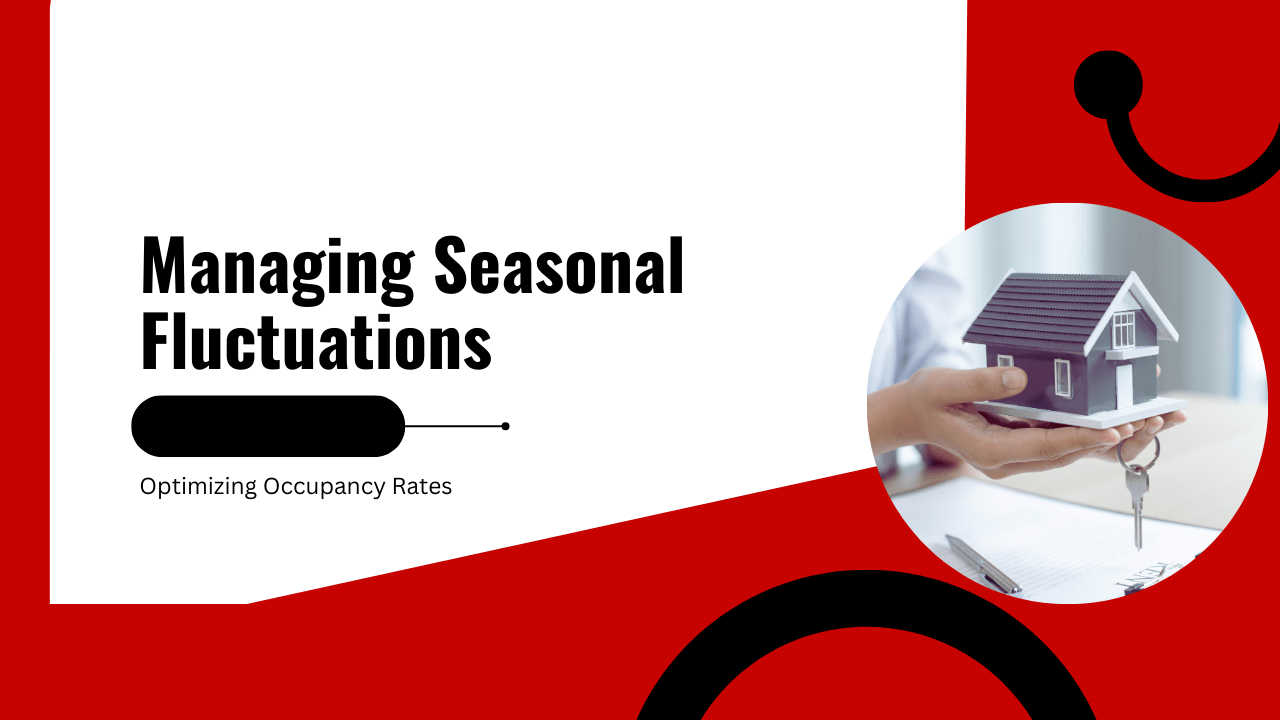For long-term rental property owners, the ebb and flow of seasonal demand can feel like a never-ending challenge.
Short-term owners and people who rent out vacation homes have made peace with the way things shift seasonally. They’ve learned to anticipate when they’ll have a waiting list and when things will be a bit barren.
When you’re committed to long-term residential lease agreements, it’s easy to take for granted that your property will always be occupied.
But, that’s not the reality.
Rental markets are inherently seasonal. While summer and early fall might bring an influx of eager prospective tenants looking for a new home, the colder months, especially winter and the holiday season, often usher in a frustrating slowdown. Empty units don’t just mean lost revenue; they also lead to increased marketing costs, wear and tear from showings, and the stress of unpredictability.
Fortunately, there are strategic ways to optimize occupancy rates even during off-peak seasons. With the right combination of pricing strategy, flexible lease structuring, targeted marketing, and proactive property management, you can keep your rentals filled year-round, even when demand traditionally dips.
We are professional property managers who focus on more consistent occupancy and higher earnings. Here are some of the ways that we manage seasonal fluctuations to optimize occupancy rates.
Understand the Seasonal Landscape of Our Local Market
Portsmouth, Newport News, and Hampton Roads all have their own nuances when it comes to the details in the rental market. And before committing to tactics that will support better occupancy, it's important to have a firm grasp of your local market’s seasonal trends.
Urban areas near universities might see turnover in late spring or early summer, while vacation destinations could experience strong demand only in summer months. Snowbird regions may fill up in the winter with retirees escaping colder climates.
Use historical data from your own rentals and the data property managers like us can provide to understand:
When tenant demand peaks and dips
What rental rates fluctuate throughout the year
What types of tenants are most active in different seasons
With this insight, you can make data-informed decisions to reduce vacancy risk before it arises. You’ll be more prepared for fewer applications or a surge in showings.
Strategy 1: Create Flexible Lease Terms
Traditional 12-month leases are standard, but rigidity can leave you vulnerable during the off-season. Consider how your lease structure could better accommodate seasonal realities:
Offer Variable Lease Lengths
Rather than only offering one-year leases, add options for 6- or 9-month terms that stagger lease end dates to align with high-demand seasons. For example, a lease ending in May or June will allow you to relist the property during a peak rental period. You can also offer incentives, such as a discounted rent rate or free WiFi for the first month for tenants willing to end their lease in a peak month.
End-Of-Lease Adjustments
Most tenants expect that rents will go up when they renew a lease agreement. You’ll want to increase what you’re earning, but think about ways that you can leverage a lower increase in order to keep your tenant for longer. This might allow your next lease renewal to arrive in a season when market rates are expected to shift.
Furnished Options for Shorter-Term Tenants
During low-demand months, consider offering a furnished unit at a premium to attract business travelers, traveling nurses, or relocating professionals. These tenants often need housing for 3–6 months and prefer flexible terms. This can be difficult to implement, especially if we’re talking about a property that you normally rent out for the long term. It’s simply something to think about if you’re looking for a way to keep your properties occupied when no long-term renters are interested.
Strategy 2: Adjust Pricing with Smart, Competitive Offers
Price sensitivity is a real factor during the off-season. When fewer people are moving, pricing becomes one of your most powerful tools for attracting tenants.
Implement Dynamic Pricing
Use dynamic pricing tools when necessary to adjust your rent competitively. During slow months, a $50–$100 reduction could be the difference between a quick lease and months of vacancy. You have to know where to land. Don’t discount it too much or you’ll have trouble bringing your rents up to market. But make the discount meaningful enough to attract tenants. And don’t forget to factor in vacancy loss. A $50/month discount over 12 months ($600) is far better than losing one month of rent entirely.
Prioritize Incentives Over Discounts
Rather than cutting base rent, offer move-in incentives such as:
One month at half the rent (prorated across the lease term)
Reduced security deposit
Gift cards or referral bonuses
Free parking or utilities for the first few months
These offers grab attention without devaluing your property's market worth long-term.
Strategy 3: Refresh Your Marketing Approach During Low Seasons
In slower months, your listings must work harder to stand out. This is the time to level up your marketing game. Be sure you are making good use of:
Professional Photos & Virtual Tours
In cold or dark months, it’s even more critical that your listing looks bright, clean, and inviting. Invest in professional photos and create 3D virtual tours so potential renters can get a feel for the property without needing to visit in person.
Target Specific Audiences
Who is moving during this particular time? Students? Remote workers? Retirees? Differentiate your marketing efforts depending on who is most likely to be looking for a new home during the off-season. Tailoring your messaging makes your property more appealing to niche markets.
Advertise Beyond Traditional Channels
Don’t rely solely on Zillow or Apartments.com. These can be valuable spots to showcase your listing, but think creatively. Post your listing in local Facebook groups, LinkedIn, and Nextdoor. Short videos on TikTok or Instagram reels can also bring in younger renters.
Strategy 4: Keep Units in Top Condition
During slow rental periods, the condition of your unit can make or break a lease. When options are abundant, small flaws can steer tenants elsewhere. Here’s how to ensure your property shines:
Winterize and Beautify
Ensure your heating system is working perfectly and add energy-efficient lighting and bright decor to combat dreary winter vibes. If you allow pets, consider adding a small fenced area or dog-friendly features. Highlight any features that provide year-round comfort: fireplaces, insulation, soundproofing.
Create a Quick Turnaround for Maintenance and Cleaning
If a showing request comes in, your unit should be spotless and ready. A deep clean, freshly painted walls, and updated fixtures can elevate your unit above similarly priced alternatives.
Strategy 5: Build and Maintain a Year-Round Lead Funnel
Sometimes the best way to combat a slow season is to get ahead of it. Building a pipeline of interested tenants year-round reduces the scramble during a vacancy. A property manager can be your secret weapon. We have strategies that will help to:
Create a Waitlist or Interest List
Allow interested applicants to join a waitlist if the unit is currently occupied. When a lease nears its end, reach out to this group before listing publicly.
Stay in Touch with Former Tenants
Offer past tenants a referral fee if they send someone your way. A small incentive (like $200 upon lease signing) can yield great returns and bring in trustworthy applicants.
Leverage Property Management Software
We invest in innovative platforms which can automate tenant communication, manage applications, and ensure you’re not missing leads that come in through your website or ads.
Strategy 6: Build a Reputation for Responsiveness and Reliability
Tenant satisfaction influences word of mouth and reviews, which are two key factors for sustained interest, even during slow seasons. A well-run property with a responsive landlord is worth a premium in any season.
Encourage Reviews
Ask happy tenants to leave Google or Yelp reviews. Future tenants often research landlords or property managers before leasing. Be proactive with the ask.
Respond Quickly
Set up auto-responses or chatbots to field inquiries quickly. The first landlord to respond is often the one who secures the lease.
Focus on Long-Term Value
While short-term wins (like a rent discount) are helpful, a reputation for professionalism pays dividends over time. When tenants trust that their issues will be addressed and their lease honored, they’ll be more likely to renew or at least recommend the property to others.
Seasonal slowdowns are an inevitable part of the rental business. That doesn’t mean they have to be painful. By approaching them with flexibility, smart pricing, and tailored marketing, you can mitigate vacancy risks and maintain strong occupancy rates year-round.
 Think of the off-season not as a setback but as an opportunity: to test new approaches, explore different tenant demographics, and fine-tune your leasing strategy for even better performance in the future.
Think of the off-season not as a setback but as an opportunity: to test new approaches, explore different tenant demographics, and fine-tune your leasing strategy for even better performance in the future.
Vacancies may be cyclical, but with the right tools and mindset, your success doesn’t have to be. We’d be happy to help with this. Contact us at Doud Realty Services, Inc. We provide expert property management in Norfolk, Portsmouth, Hampton Roads, as well as surrounding areas such as Virginia Beach, Suffolk, Chesapeake, and Newport News.


